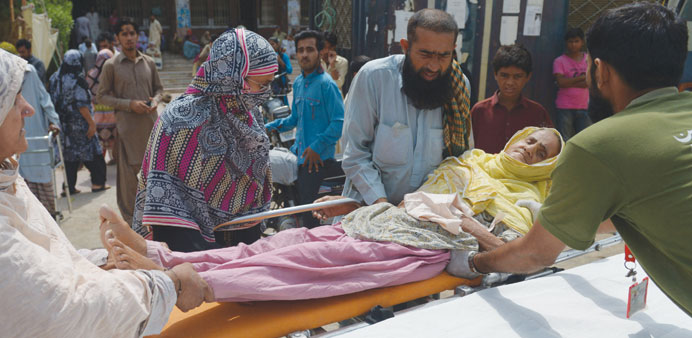IANS/Islamabad
Pakistan Prime Minister Nawaz Sharif flew to the mega port city of Karachi yesterday, where a relentless heatwave has killed more than 1,200 people over the past 10 days.
Sharif presided over a meeting of senior officials on the “recent intense heat wave in Karachi and the resulting casualties”, a PM office press release said.
The prime minister was informed that the heatwave hit Karachi on June 19 and more than 65,000 patients were reported in Karachi hospitals during this period, out of which more than 1,200 lost their lives.
“Most of those who lost their lives were homeless people whose dehydration was aggravated due to fasting during Ramadan in the extreme weather,” an official said at the meeting.
Hundreds of people were still being treated in at least four government-owned and private hospitals, the provincial health departments said.
Opposition parties criticised authorities in Karachi for failing to launch a campaign to ensure that people should not be exposed in the sun when the severe heatwave was approaching. The meteorological department argued that a break in the routine sea breeze in the city of nearly 20mn people caused the heatwave.
The frequent power outages and shortage of water in Karachi were also blamed for the high number of deaths.
Sharif described the heat wave as “unprecedented in the history of Pakistan” and promised that all departments which “shirked their responsibilities adding to public misery would be held accountable in a transparent manner”.
The prime minister said lessons should be learnt from such calamities and measures should be taken to avoid their recurrence in the future.
Officials said hundreds of shelters have been set up by local authorities, the military, political parties and social welfare groups to treat the affected people.
Director of Pakistan Meteorological Department Mohamed Hanif said high humidity and low wind caused the severe heat wave.
Meanwhile, this year Pakistan will receive normal monsoon rainfall. However, higher intensity rains are expected in Khyber-Pakhtunkhwa (KP) and northern Punjab. Meanwhile it is feared that the drought-stricken areas of Sindh and Balochistan will receive low rainfall which may aggravate the drought situation.
These points were shared in a day-long Co-ordination Conference organised by the National Disaster Management Authority (NDMA) at the Prime Minister Office Auditorium yesterday to review the state of preparedness for the monsoon season- 2015.
On the occasion NDMA shared a few pointers on the National Monsoon Contingency Response Directive-2015 based on experiences of past floods.
During the meeting senior officials of Pakistan Meteorological Department informed the participants that it expected to receive below average rainfall during the monsoon season. Majority of the rainfall will be received in the last week of July till end of August, according to the Met office.
Prevalence of strong westerly system in Afghanistan and K-P are forecast. Chances of an erratic monsoon because of climate change have also not been ruled out.
In the meeting comprehensive response guidelines about preparedness, early warning, rescue, relief, rehabilitation and coordination points were highlighted. The role of disaster management organizations, federal and provincial departments and humanitarian organizations also came under spotlight.
An official in PMD who wished to remain anonymous said considering the current weather patterns, it is expected that Pakistan will receive slightly below average rainfall.
However it is expected that the climate change could affect the pattern of monsoon rainfall in Pakistan, he said.
“Chances are that some parts of the country could receive rainfall for a short time which could cause floods”, he said.
The official said that just like previous year there were low chances of floods in the country. However in September heavy floods triggered by monsoon rains affected vast lands of Punjab and Azad Jummu and Kashmir and claimed over 130 lives.
Senior environmental expert Pervaiz Amir said that Pakistan’s monsoon rains intensity depends on how much neighbouring country India receives.
It was entirely dependent on the amount of rain received by the catchment areas of Jhelum and Chenab rivers. He also mentioned that the intensity of monsoon rainfall depends on the heatwave intensity experienced before the start of the season.
“Unfortunately PMD forecast is based on its 100-year-old models, not on what is going around,” he said.

Pakistani relatives shift a heatstroke victim to a hospital in Karachi yesterday.
